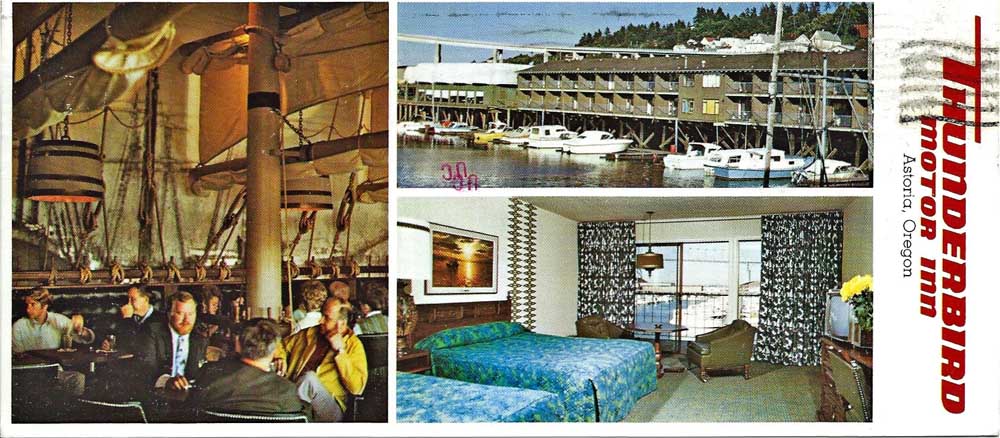Well Preserved: Thunderbird Inn 400 Industry St., Astoria, Oregon
Published 6:47 am Wednesday, May 18, 2016

- A postcard from 1978 captures the Thunderbird Inn at its peak.
ASTORIA — Chester Trabucco and Bill Orr are the latest developers to tackle the former Thunderbird Inn. The motor lodge has a controversial past. Newspaper accounts show legal woes reaching back more than 30 years, with multiple developers. Each developer wrestled with whether to maintain the status quo or reinvent lodging’s image. Most recently, Brad Smithart attempted to establish it as a moderately priced, modestly attired motel.
Trabucco plans to bring some of the sensibilities of an earlier project, the Hotel Elliott, to his latest venture. However, he is also exploring — in limited use — “theme rooms.” Trabucco engaged local consultant Jeff Daly to stage several rooms. Each will reflect Astoria’s history and industry. The result is bold, but not without its precedence.
Long-time area residents will remember the Sea Fare Restaurant. Opened in 1960, it claimed to be Astoria’s only waterfront seafood eatery. Diners enjoyed meals beneath an open truss ceiling, surrounded by wood paneled walls and sweeping views of the West End Marina.
In 1968, the Thunderbird Inn was constructed west of the restaurant. The motel boasted 124 rooms, all constructed on piling, facing the marina. The motel’s arrival coincided with the death of one of the city’s icons: the John Jacob Astor Hotel. Downtown hotels simply could not compete with motor lodges. This was particularly true after the construction of the Astoria-Megler Bridge in 1966, which ended Astoria’s ferry service. Car loads of tourists were no longer forced to arrive or pass through the city’s downtown. Instead, the bridge escorted them to Uniontown where motels were staking their claim.
In the 1970s, the Sea Fare Restaurant morphed into an extension of the motel and emerged as a high-end, themed establishment called the Seafare Restaurant. The dining room looked like the deck of a large sailing vessel. Ship masts, rigging and unfurled sails divided the space. Light fixtures were constructed of wood kegs, halved and hung by chains from the ceiling. At its time, the restaurant was the apex of Astoria’s dining experience.
Developers across the country use history, or the evocation of it, to revive their hotels and communities. For instance, in Savannah, Ga. — one of the most historic cities of the South — the downtown, 1964 Thunderbird Inn was entered on the National Register of Historic Places and restored. Promotional material says it “blend(s) history with a seamlessly chic getaway.” It’s also phenomenally popular.
Here, Astoria’s Robert Jacob chose to create a historic themed hotel rather than restore a building. His decade old Cannery Pier Hotel, evokes the spirit of an 1897 cannery. A curated collection of historic photos graces its hallways and transports guests to a time when canneries were king. It, too, has been highly successful.
“It’s exciting,” said Daly as he looked around the former Thunderbird Inn. “We’re taking the rooms and giving them a local, historical look.” Although still in the conceptual stage, Daly is designing rooms based on Uniontown, the Astoria Column, “The Goonies” and the Astoria-Megler Bridge.
To Daly, the existing rooms, with minimalistic detail, are clean palettes. He envisions photographic collages on one or more walls, each featuring artistically rendered, regionally iconic images. Jeff Miller of Red Dwarf Graphics will produce the collage. Daly also imagines the use of industrial materials, such as corrugated metal, on other walls.
Paul Tutor of My Grandfather’s Nails and Becky Johnson of Vintage Hardware will provide architectural embellishments as well as reinterpreted furniture. “We’re re-purposing local materials to tell a story about each room,” explained Tutor. For example, salvaged beadbard and doors might be incorporated into headboards. And, Tutor says they will create one-of-a-kind tables and chairs for each room.
“This project is for Astorians, by Astorians,” said Trabucco. Beyond using local contractors to rehabilitate the structure or featuring local artists in all of the rooms, Trabucco sees the project as a vital part of creating a “marine village.” Other businesses — seafood, restaurants, hoteliers — are all invested there he said. “We are eager and willing to do what is needed to do the same.”
For more information about renovating an old home or commercial building, visit the Lower Columbia Preservation Society website at lcpsociety.com.






